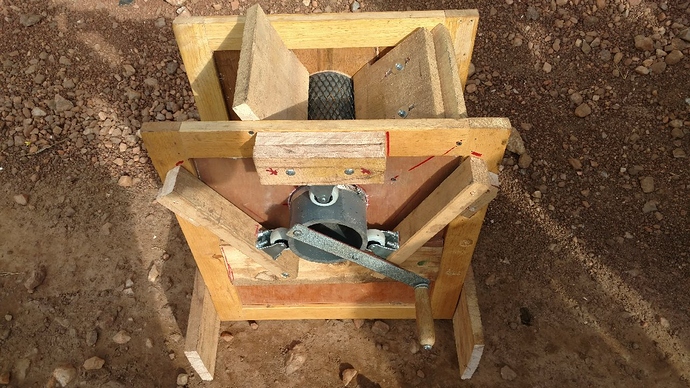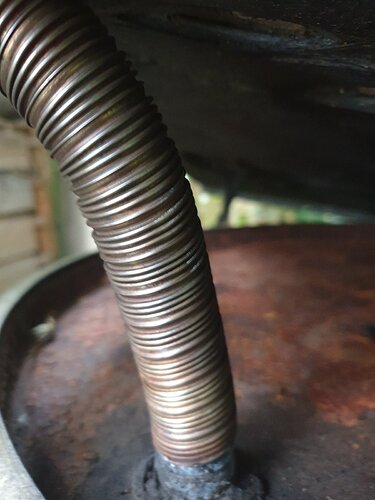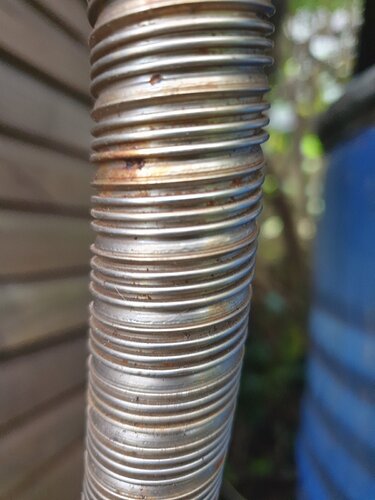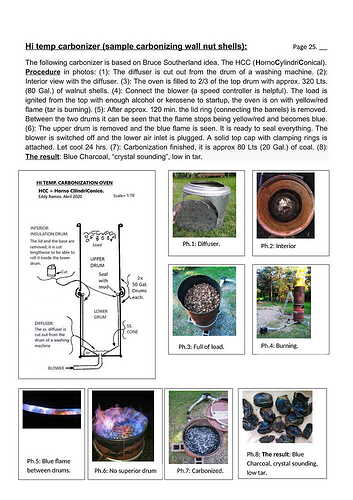The flexi pipe used for exhaust’s does not leak , maybe they were using the flexi pipe that is used to carry electrical wire i think that is just wound in a coil and comes apart when pulled hard .
You must do what ever is best for your set up , we all have materials that are easier to come by than others , it don’t make it the best , just the best for us at the time , it may even work out that the sump hose works great on your build , remember you are the first to try this new design out so really your the ground breaker here .
Dave
I’ll think of something. I will try to use as much PVC as possible en route to the engine itself but I know it’ll have to make some crazy turns so I’ll definitely need sump hose the closer I get to the engine. Luckily there’s a huge gap between the serpentine belt and the radiator since it uses electric fans. Run it up the passenger side and between that area.
In the mean time I’m making an attempt at a Gilmore style crusher out of that dumpster wheel. Just need to find some pipe to sleeve the center down to a 3/4" keyed shaft.
If I had some heavy grate or expanded sheet metal I’d just as soon do the stomp method. Kinda want to see what adding a blade to a paint mixer would do and chop it up in my holding barrel.
I think I’m just going to start sizing my wood for charcoal. I’m at a dead end with grinding and it’s getting to the point I want to pay someone to make a unit for me sans motor.
Cody in all honesty unless your wood is massive don’t worry about spending time cutting it to size , even just shoveling the charcoal out of the retort will make it smaller .
Keep a look out for a old garden mulcher /shredder the ones with the hammers that swing round , i have one i use and run it with a 12/24 volt motor through a 1 inch grill , it makes a lovely job less dust at slower speeds too , you can normally find them on second hand garden tool sites or ebay the likes
Whenever l hear “flex exhaust pipe” l get a few nasty flashbacks… This things burned a big unnessesery hole in my wallet and a lot of frustration. Impossible to fit to seal 100%. They fail from vibration over time. They rust like crazy… Even the industrial stainless one that set me down about 30 $ a foot was useless!!! They are all designed to be layed down and let be still, not to move atound all the time like on a vehicle.
Im with Dave on the plastic after the cyclone. Save your self some frustration and re doing and rethink about this. It is possible you get a bridge in the gasifier, or even just if you run out of fuel and the gasifier will become a heater. In such a case, power goes down and instinctively an unexperienced operator will try and push the pedal more, making things even worse… I have sucked in some barrels before 
I don’t know if this will help with your charcoal grinding, but this and the following posts #25-29 show my approach.
Right now I have about 16 5/8" round bar nubs welded to the dumpster wheel. I just need to get off my butt and make the comb. It’s just annoying dealing with the stuff I have to build with and only having two days a week to work on things. Really frustrating when for 5 days in a row you can just stare at something and not have enough productive time to get anything done.
I really like the biochar grinder you made for a mission, I’m wondering if there’s a way to utilize that diamond plate wheel to get bigger pieces without adding teeth.
Maybe widening the gap between the drum and the chute boards?
I don’t see how expanded metal could work for producing charcoal nuggets. Likewise, the mills made with counter-rotating drums work well for crushing small seeds/grains, but will not work for making gasifier fuel.
Cody,
The “stomp” method with expanded metal works for me. I’m convinced that it is just as fast as a hand-cranked grinder. It seems crude—like pressing grapes with your feet—but it works. I notice Eddy Ramos uses that method, too.
Right now I’ve just been pre sifting the big stuff out and crushing it with a truck inner axle that still has the flange and lug bolts attached. I get about 50/50 correct sized charcoal and big pieces. I need to try out Bruce S’s double barrel method that Eddy Ramos documented.
I’m just a little confused as to how much is loaded up. Is the whole length of both barrels loaded or just the bottom barrel like a normal TLUD with an afterburner? And by speed strip he meant a lever locking ring?
Cody,
I think Eddy’s two barrels attached with a locking ring setup is for charcoaling nut shells. The first two-barrel method he describes is just like Gary Gilmore’s—the bottom barrel is completely filled with wood, metal bars are laid across the top, and the top barrel (with both ends removed) is placed on top of the metal bars. It is simply a chimney to help burn off the gasses and eliminate smoking.
Ah alright. Yeah I just use the normal method that Gary has shown. Wasn’t sure if the Bruce method was just for the small sized pieces or if it would also work with wood chunks.
Luckily my downdraft isn’t picky as far as char size, as long as I keep it smaller than the palm of my hand. I aim for thumb sized at the biggest.
Hi Kristijan I guess there are many types of stainless flexi verses stainless flexi , for my pipes now been in use for over 5 years they are still perfect all be it they are on a stationary unit and only 23.5mm inside dia , let me race outside and get you a photo
As you can see this flexi tube is a solid stainless tube that is then formed into a series and folds that allow for the flexibility of the whole tube and not wound like most flexi tubes i have seen before , anyway this has got real hot a few times in its life as the discoloration shows , the fittings on the end well i use a hydraulic barb that is nice snug fit into the end of the tube , never a leak at all very pleased , but again how this would cope with the bumps and rolls of a road is anyone’s guess but i am sure there are workarounds .
All the best
Dave
Ya that’s definitely not the normal stuff you see in exhaust shops and parts stores around here…I’d actually like to know where you purchased that flex pipe from, I’ll need some for my build If it comes in 2 1/4" flavor
The flexi pipe came in the scrap from a local company , far too good to throw out and scrap but some company’s don’t seem to care what they throw out .
At the time it came in i was not at the yard and so asked Brian the next time he comes into get the name of the company so we go see what other sizes and goodies they may have , that was 5 years back and Brian had a stroke not long after and so never got round to finding the guy again , what does not help as well is Brian suffers from not being able to recognize faces .
Dave
If you are referring to the method below, please note that Eddy’s first picture misses the main advantage of this approach. The flue pipe is capped for startup and the under fire burns up through the 2" holes and through the load of wood, NOT up the flue/chimney. This drives off moisture and begins to pyrolyze the load. The rest of Eddy’s pictures and descriptions are good. [quote=“ramosedmundo, post:113, topic:2364”]

You load up to the top, the inner (30 Gal) drum with the wood to be pyrolize. The 55 Gal drum is supported by three bricks. Then you start a fire underneath the 55 Gal drum. Help to start the fire with a blower.
[/quote]
That’s a great design but I meant the one that you strap two drums one on top of the other, with a washing machine drum grate at the bottom and a single air inlet at the bottom with a blower. Looks great for small stuff like what Eddy uses.
That is an excellent design by Eddy. I use something similar for classified wood chips. BUT, this is a TLUD (top lit up draft) that REQUIRES uniform size feedstock like Eddy’s walnut shells to produce a thoroughly carbonized/pyrolyzed product with low ash. For feedstock of random dimensions, I recommend the design I mentioned above or a simple open kiln that will require a bit more tending. For the best results using random feedstock, consider a curtain kiln.
Yeah I saw ChuckWs barrel method. I’ve been using a simple TLUD with minor success but it’s because my feedstock is random. I’m going to try the flame curtain method this weekend with a fresh barrel.
If you use an air manifold or a slotted pipe to shoot a curtain of air slightly down into and across the feedstock–be warned. This method creates very high temperatures. I wear a welding jacket, face shield and thick leather gloves when I am tending a curtain kiln. It eats almost anything and in the process of poking the glowing coals before adding the next layer of wood, I am breaking charcoal down toward engine fuel size.



